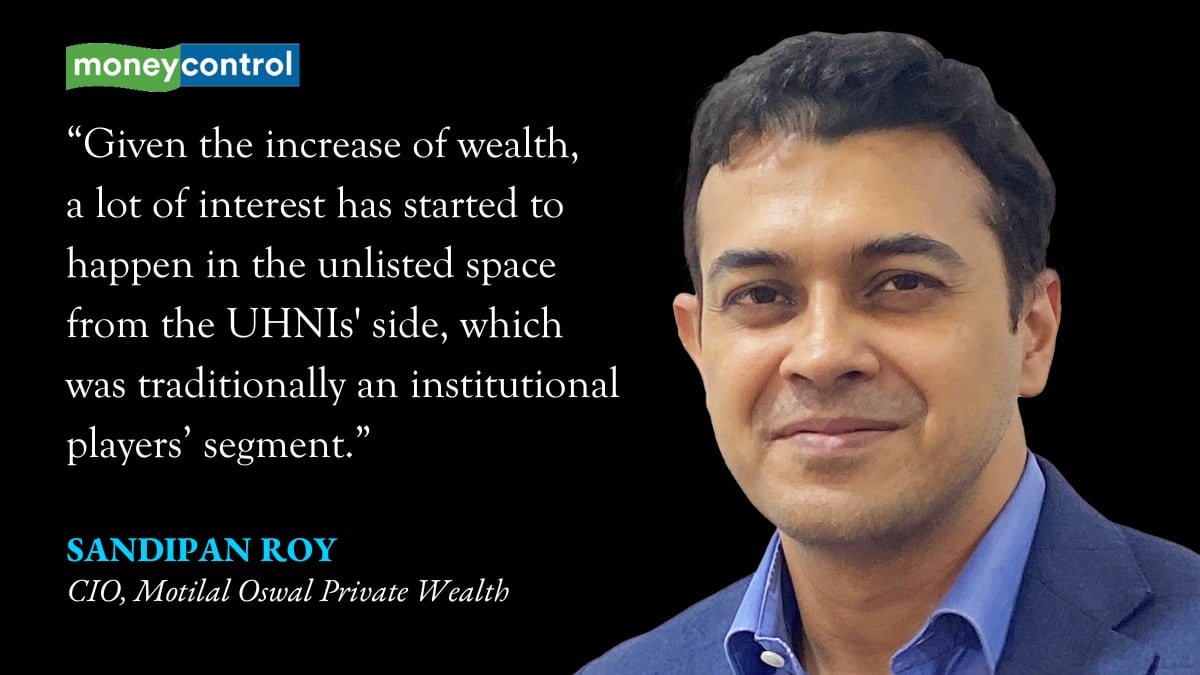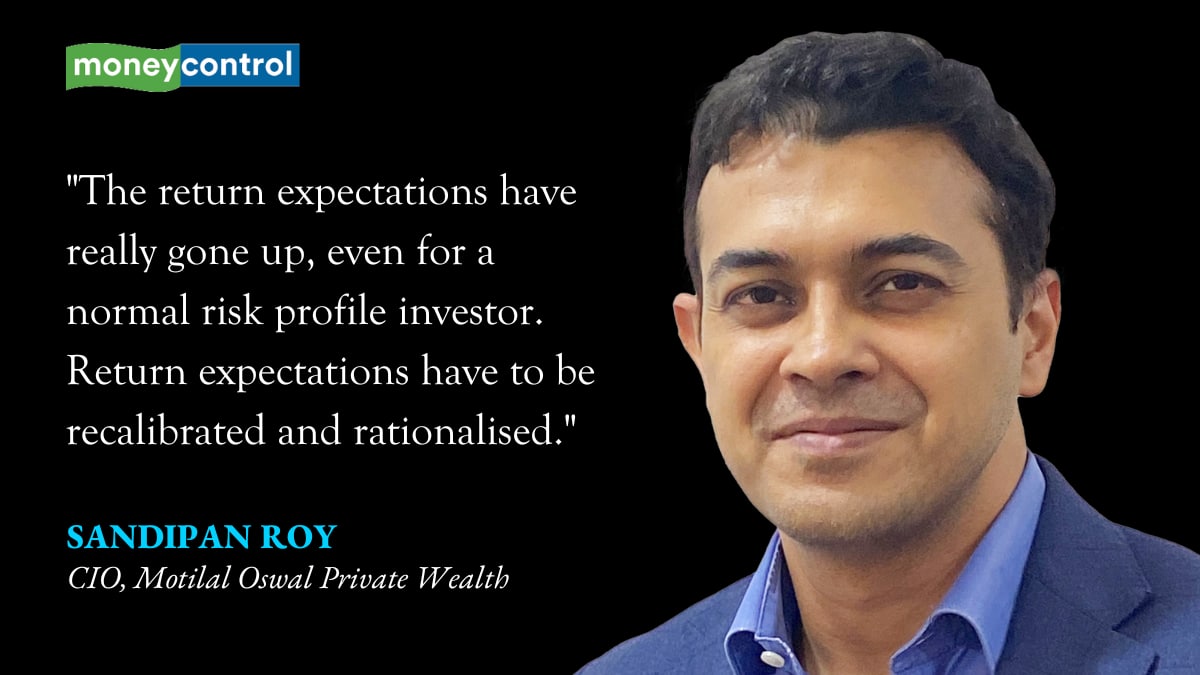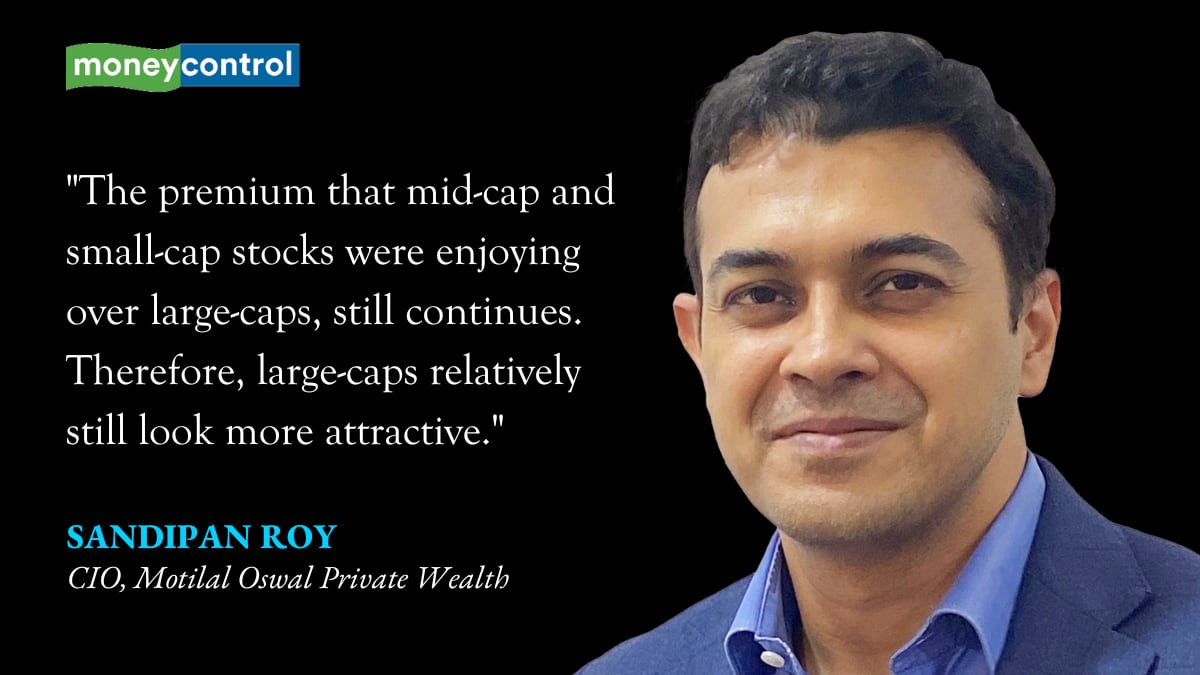



Sandipan Roy, Chief Investment Officer, Motilal Oswal Private Wealth believes that the equities market is betting its horses now on sectors and stocks that have shown steady earnings growth and palatable valuations. This is why the investment management firm has also shifted the stance to fundamentals from flavour of the season.
Motilal Oswal Private Wealth (MOPW), a part of the Motilal Oswal Group, caters to corporates/institutions, High Net Worth (HNI) and Ultra High Net Worth Individuals. MOPW manages wealth of over 13,390 HNI families with assets under management of over Rs 1,57,000 crore as of September end.
In an interview with Moneycontrol, Roy talks about how the investing style of UHNIs has changed over the years, what innovative investment solutions they are looking at and the risky trends in this space.
Edited excerpts:Give us insights into how UHNIs are investingGiven the increase of wealth, a lot of interest has started to happen in the unlisted space from the UHNI's side, which was traditionally an institutional players’ segment.
Even on the private equity side, a lot more UNHI investors are wanting to take direct exposure in the mid-cycle companies, rather than going through the fund route. Or even if they're coming via the fund, negotiations are that they should have co-investment rights.
Also read | Specialised investment fund: How this new asset class will work and help investorsFurther, on the private equity side or the unlisted space, we feel valuations are far more palatable or reasonable, given the drying up of liquidity in that space. The focus is on EBITDA (Earnings Before Interest, Taxes, Depreciation, and Amortization) accretive business models or unit economics. If it is not EBITDA accretive, the probability of them raising funds drops, because of which, business models have become far more fundamental driven and valuations have become far more reasonable.

Hence, naturally, smart money or intelligent investors' money has actually moved there. A host of investment activities are happening in late-growth to pre-IPO stage companies where you have already seen the company achieving EBITDA positivity, and there's a path to profitability and also a path to listing. So, interest has shifted to where exits are more or less defined.
This investment is becoming almost 30-35 percent of UHNIs' portfolios.
Are they preferring any specific kind of companies in this pre-IPO stage?The earlier generation of companies went through their natural elimination journeys, while others matured like Flipkart. The next generation of companies is now going to come up for IPOs or has been recently listed, like Pine Labs, Swiggy, Razorpay or Mobikwik.
Then there is a generation, who are maybe two years away from IPOs. This segment of companies is seeing a lot of interest. We did a big trade in Zepto, which is talking about an IPO in the next one year.
Also read | How to manage the impact of declining bond yields?We also did the biggest-ever domestic fundraise, that too from the non-institutional space. We tapped into family offices and UHNIs, where we managed to raise more than $250 million from them out of the $350 million total fund raising. So that is the amount of demand that is there from the UHNI space, and these are not small tickets - the average ticket was actually Rs 30 crore.
These are not small ticket investments by investors, they are willing to loosen their purse for the right kind of opportunity, where there is unit economics, where there is EBITDA positivity, path to profitability, and there's an IPO exit at some point.

We invested $100 million in Swiggy, $250 million in Zepto and $50 million in OneSource Specialty Pharma. We'll keep on doing a lot of such curated deals, where we find a lot of unit economics, which are EBITDA accretive, and we find a definite early exit. These would be pure bottom-up again; no sectoral preference, but a pure bottom-up approach based on business fundamentals.
Do you have any sectoral preference?We have a slight bias for supply chain kind of strategies. A lot of supply chain inefficiencies that are there, which can be flattened, it is something we really like.
Are UNHIs looking at any opportunities overseas?Most investors are. Ultimately, India is just 5 percent of the global space in terms of market capitalisation and the US is around 70 percent. Demand for and interest in overseas investments has only increased. We are seeing a lot of activities, through the LRS (Liberalised Remittance Scheme) route, through the OPI (Overseas Portfolio Investment) route. A lot of clients anyways have funds outside, so they are wanting advice on the funds that are outside.
Any innovative investment solutions HNIs are looking at right now?Yes, they are looking at opportunities in the structured credit space and in the unlisted equity space. Leverage is also something that is playing out beautifully in the ultra-rich space.
For example, we have launched India’s first integrated leverage solution on our own real estate fund. So, clients actually get 1:1 leverage on our real estate fund.
The bundling of products is something that will keep on increasing going forward.
Wherever you can create exclusivity, you can create a proper curated idea, with a separate share class and all that, clients want it, and they're willing to pay for it.
How has the investment style or preference of this investor class evolved over the years?They have evolved from being risk-averse to risk-taking. Earlier there used to be a discussion on asset allocation where largely the allocation was going into preservation of assets and obviously, real estate was the preferred choice. A lot of discussions used to happen around saving tax as well.
Nowadays, discussions don't happen around tax anymore. Now the discussion has given way to a far more matured and more nuanced discussion around what is the objective and what is the horizon. Now discussion has moved away from talking about risk to talking about the duration. Depending on the duration of the investments, risk is being allocated. Hence, growth asset allocation has completely taken over the portfolios.
Also read | Weathering the storm: Smart wealth preservation strategies in volatile marketsThere is a lot more propensity to invest in growth assets or experimental growth assets like start-ups, unlisted equity, pre-IPO deals, structured credit and venture debt. Even in the fixed-income or when it comes to preservation of assets, the hunt for yield is very high. People want to be compensated for their investments.
Are UNHIs looking at opportunities in the SME market?They're not playing in the SME market as of now, or even if they are, they are doing small allocations in the companies they know about or perhaps (where) they know the promoters. Speculation will be less there.
Any risky trend you are witnessing in the UHNI space?The return expectations have really gone up, even for a normal risk-profile investor. Return expectations have to be recalibrated and rationalised.
What are your views on the market for 2025?From May 2024 onwards, we started suggesting staggered investments as we were not comfortable with the valuations.
Also read | Here is how your marriage can affect your credit scoreObviously, then the markets had a very healthy correction, which was normal in a pure bull market. Now, we think it's time to stay with large-caps for a bit longer. So, if you have to put money today, you should put it in large-caps. In mid-cap and small cap stocks, we are still saying that you should stagger it over the next three months.
Let Donald Trump take over the office, and then we will see what the real policies are.

Large-cap, mid-cap, small-cap, all corrected by the same rate – 10 percent each. Which is unprecedented because, traditionally, we always felt that mid- and small-cap are high beta. So, they should be falling more than large-caps.
The premium that mid-cap and small-cap stocks were enjoying over large-caps, that continues. Therefore, large-caps relatively still look more attractive.
Discover the latest Business News, Sensex, and Nifty updates. Obtain Personal Finance insights, tax queries, and expert opinions on Moneycontrol or download the Moneycontrol App to stay updated!
Find the best of Al News in one place, specially curated for you every weekend.
Stay on top of the latest tech trends and biggest startup news.